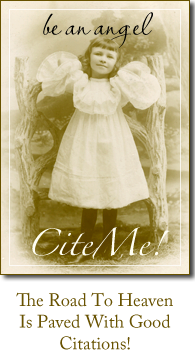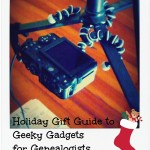
What’s that in the road, a head?
Do we use our iPhone to find the Coroner or GoogleMaps?
FootnoteMaven has tossed the ball back into the game and WE’RE TALKING PROPER CITATIONS ON THE BLOGS AGAIN! Thank you, fM, for the heavenly angel badge. (Yes, do see Amy’s Genealogy, Etc. Blog for I Don’t Care Where You Put the Comma).
Ouch! I LOVE commas. ADORE periods. AM TANTALIZED by semi-colons. My background is journalism and literature, and I’ve taught both subjects. My favorite books are dictionaries, style guides, and thesauri.
I’ve probably read (and graded) more English papers than I have names in my family tree. Only a few students truly grasped the concept of correct MLA citation style; many more submitted creative alternatives ranging from 4th grade Bibliography style to APA to very personal renditions of a Works Cited page.
I have a litte theory about this, and it may even have some bearing on citations in genealogy —
Genealogists aren’t all that different from high school English students.To be honest, most of us would rather hunt for ancestors than craft citations.
There’s not much FUN in fundamental citations.
Citation standards can become “counterproductive” to actual research, I agree. It’s hard to keep the train moving when we keep stopping to analyze source citation format as well as source information. But, what would happen if we stopped thinking about our genealogy databases as citation machines a la EasyBib and just considered our databases as a kind of Working Notebook.
I never required students to write a proper MLA citation on their research notecards or notes; it would slow down their research. All they had to do was get enough information to put together a correct MLA citation at a later time. If the student knew enough about MLA to get the author, title, publishing information, etc. they could usually construct the Works Cited page. Some students, however, got a little lazy and only included the journal name, not the article title, or missed the journal volume and number. They were up the proverbial creek without a paddle.
Any genealogy database that helps us obtain all the information needed for a correct citation — whatever format that might be — can only help the genealogy researcher. IF I choose to use Evidence Explained style citations, I will need a full data trail for the census I am viewing on Ancestry.com. I appreciate programs like Legacy7 and RootsMagic4 that offer source templates to remind me to include this full source trail. When I use software that only prompts me for Title, Author, Publishing Information, I may forget to include the source of Ancestry’s database. Later, when I go to write a correctly formatted citation for my about-to-be-published article, I find I am missing a crucial piece of the citation puzzle and have to retrace my work. Much better to have all the pieces ready for me to assemble into the full picture.
So, sorry Amy, I do care where you put the comma — in your final paper. But you are so right, genealogy can be a whole lot funner!
Go ahead, cite me!






I think it's all in point of view. Knowing and practicing fundamentals doesn't really slow you down if you consider that a speedy result that is lacking in citation format details is going to take away from your future discovering time by forcing you to retrace previously-covered ground.
I think it's a matter of good habits and a proper foundation. Going back to look for missing elements is time consuming and frustrating. I would much rather be making new discoveries.
My citations are not perfect, but then neither am I. But they are there.
I WILL slow my research down to grab all the information needed for a proper citation. I suggest that everyone find ways to make that task easier, be it a program, a "to be filled in" pdf form, an always open blank page, etc.
If we teach all NEW genealogists to form good habits from day one, the road to genealogy heaven will be paved with good citations.
-fM
Amy,
Understood. Publication requires that we play by the rules.
And, I agree with you as far as it doesn't really matter how you cite things while you're "getting there."
The big, HOWEVER: I find that I'm a bit like my lazy students. When it comes time to write that correct citation, I really don't want to have to do my research all over again. To that end, I try to get all those key elements the first time, with or without proper punctuation — the comma I can add later.
As fM says — If you can't be handsome, at least be handy.
Thanks for the good discussion!
I'm sorry that I didn't make that point clearer. I do care where you put the comma — if you're going to submit an article for publication or publish a family history. You have to conform to that journal's preferred style sheet. If you're self-publishing, following an established style, such as CMS, MLA, APA, etc, gives your work a degree of authority and makes it easier to read. It's the *getting there* that doesn't worry me. And while it is ideal to have all of the elements there so that you can create your format-perfect citations for publication, I've yet to see anyone who hasn't had at least one element that they had to track down later. We're human; it happens.